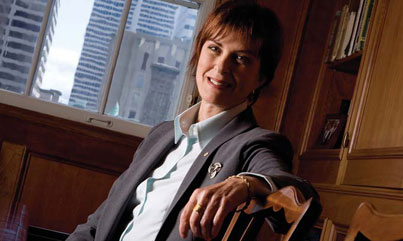From the Desk of the Principal
Going Greener

Christinne Muschi
On September 18, McGill's new Life Sciences Complex, the largest construction project in the University's history, landmark moment, one our research community has anticipated eagerly.
This magnificent new complex has been carefully and creatively designed to foster interdisciplinary collaboration and to promote the link of McGill's basic science to practical, high-impact applications. Thanks to the aspirations of our scientists and the generosity and vision of Dr. Francesco Bellini, Rosalind and Morris Goodman, other donors, the Government of Canada and the Government of Quebec, our exceptional scientists will now have world-class, state-of-the-art facilities to support their work.
The moment is significant for other reasons. From its green roof right down to the grey water collection cistern under the building, the new Complex has been constructed to meet LEED (Leadership in Energy and Environmental Design) standards, which encompass design, construction and ongoing operations. The building isn't just a high-tech wonder—it's very, very green.
Environmental stewardship is part of McGill and always has been. The very first act of the newly formed McGill University Society (now the McGill Alumni Association) in 1857 was to help Principal William Dawson plant trees to beautify the University's then somewhat bedraggled campus. McGill's grounds, along with the living laboratories of the Morgan Arboretum and Molson Reserve, still serve as the lungs of the city: cool, welcoming places that generate oxygen and provide respite from the urban landscape. Just outside the city, our Gault Nature Reserve preserves the cultural and scientific treasure of Mont Saint-Hilaire, which is celebrating 50 years of McGill stewardship. This year marks the 10th anniversary of both the McGill School of Environment and Macdonald Campus's innovative EcoResidence. Our researchers are known around the world for work on climate change, biofuels, extreme weather and many other environmental puzzles.
September will also welcome the opening of McGill's new Office of Sustainability. Students are working with two designated full-time staff members to ensure that this is a catalyst for sustainability progress at McGill. We have developed green building standards for all new construction and renovation, as well as a new sustainability policy. From 1996 to 2005, McGill added six new buildings, yet our total energy consumption decreased by six per cent over that period.
And as a university, we must do more. Shrinking our carbon footprint requires a systematic change in our individual behaviours and our institutional culture. McGill will become more sustainable only through a commitment that drives all of our actions and decisions—from how we construct new multimillion-dollar buildings, to each person's daily actions in relation to energy, paper and water consumption, and garbage disposal. We must become leaders in this arena, as individuals and as an institution. Nothing is of greater importance.
We must also be careful to progress via thoughtful and effective action, not knee-jerk reaction. Many institutions have committed to becoming carbon neutral—reducing greenhouse gas emissions where possible and even buying carbon offsets to achieve the balance. But money spent on offsets also reduces resources we might better use to make our infrastructure and practices eco-friendly over the longer term.
To quote a familiar philosopher, Kermit the Frog, "it's not easy being green." McGill faces a unique set of challenges — the extreme Montreal climate and resulting energy consumption, constrained budgets, deteriorating infrastructure and inefficient, though beautiful, historical structures loom large among them.
But we also have a huge advantage: the enormous commitment and drive of our students, faculty, staff and alumni, who are pressing McGill to go further, faster in greening the University and offering an example of leadership in sustainable policies and practices for the community at large. McGill is also extremely fortunate to have a deeply committed environmental advocate at the helm of its sustainability initiatives. Professor Jim Nicell, the Associate Vice-Principal (University Services), a well-respected environmental engineering faculty member, is doing a magnificent job at focusing the energy and talents of the McGill community toward our drive to go greener.
I invite you to read more about what McGill has accomplished this year in advancing sustainability—and on many other fronts—in my recent Principal's Report, found at www.mcgill.ca/principals-report-08. Thanks to all of you, we are making progress, and together we will continue to make progress.


